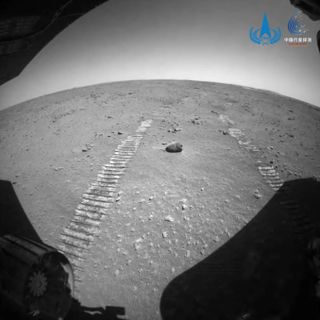China's Mars rover Zhurong completes primary mission, gets life extension
The rover will continue exploring a potential ancient ocean floor on the Red Planet.

China's Zhurong rover has completed its primary three-month-long expedition on Mars but is set to continue exploring the Red Planet.
Zhurong completed its 90-sol mission in Mars' Utopia Planitia on Aug. 15, according to the China National Space Administration (CNSA). (One sol, or Mars day, lasts about 24 hours and 40 minutes. So 90 sols is about 92 Earth days.)
Since landing on May 14, the rover has taken selfies with its landing platform and driven 2,917 feet (889 meters) across the surface, visiting its own discarded landing equipment and analyzing different rocks, dunes and other features as it went.
Related: China's Tianwen 1 Mars mission in photos

New images from the rover show the terrain that it most recently reached. Zhurong will continue to cross this area, which is thought to be below the shoreline of an ancient ocean in southern Utopia Planitia.
CNSA says Zhurong's six scientific instruments are working well and that the rover has, with the help of the Tianwen 1 orbiter acting as a relay, sent back 10 gigabytes of raw science data. That information could help scientists better understand Mars and its history, Liu Jianjun, chief designer of the Tianwen 1 ground application system, told CCTV.
"Hopefully, by providing these data to our scientists, we can get a deeper understanding of the geology of Mars, and then even see if we can find evidence of the existence of an ancient ocean in Utopia Planitia," Liu said.
Get the Space.com Newsletter
Breaking space news, the latest updates on rocket launches, skywatching events and more!
The Tianwen 1 orbiter has been passing over Zhurong's position once a day to relay data back home. Both spacecraft will go into safe mode from mid-September through late October, however, because of a solar conjunction preventing communications between Earth and Mars.
With Mars on the far side of the sun from Earth, our view of the Red Planet is obscured by the sun. Charged particles given off by the star interfere with radio communications between the planets, meaning Zhurong will need to operate autonomously, and in a limited capacity, for safety reasons. NASA's Curiosity and Perseverance rovers will also be operating on their own between Oct. 2 and Oct.14 for the same reason.

When fully active again, Zhurong will continue toward a feature described as a "groove" just over 1 mile (1.6 kilometers) away.
"If it is possible for us to see from the top to the bottom [of the groove], or if there are disparities of rock types and compositions, we could learn about what has happened in its geological history. So, this is what we're going to focus on in the near future," Liu said.
TIanwen 1, meanwhile, will sometime after the conjunction switch its orbit to allow it to begin a global survey of Mars with its own seven science payloads. Teams are devising an orbit that will allow the orbiter to begin its own detections while still assisting Zhurong, which has only limited data transmission capabilities.
Tianwen 1 launched in July 2020 and is China's first independent interplanetary mission. The spacecraft entered Mars orbit in February of this year, and Zhurong separated from the orbiter and made its successful landing in May.
Follow us on Twitter @Spacedotcom and on Facebook.
Join our Space Forums to keep talking space on the latest missions, night sky and more! And if you have a news tip, correction or comment, let us know at: community@space.com.

Andrew is a freelance space journalist with a focus on reporting on China's rapidly growing space sector. He began writing for Space.com in 2019 and writes for SpaceNews, IEEE Spectrum, National Geographic, Sky & Telescope, New Scientist and others. Andrew first caught the space bug when, as a youngster, he saw Voyager images of other worlds in our solar system for the first time. Away from space, Andrew enjoys trail running in the forests of Finland. You can follow him on Twitter @AJ_FI.
